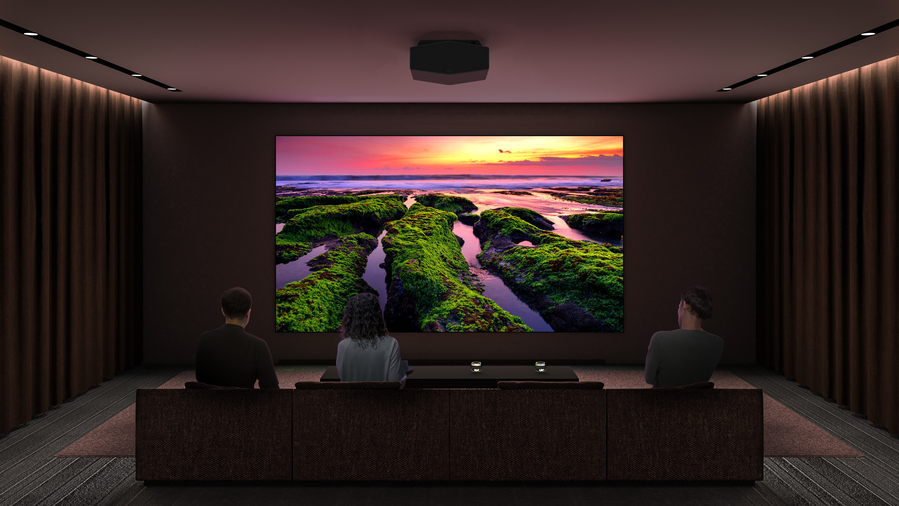Learn the Basics of Home Theaters
Design Principles Go Beyond the Big Screen & Deliver Cinematic Performance

If you still associate a home theater with a large TV and a row of comfortable seats, think again. While that concept may offer improved visuals, it misses the precision and planning required to recreate a cineplex experience in the comfort of home.
A professional home theater demands more than upgraded equipment and cozy chairs. It requires attention to acoustics, room layout, lighting control, and equipment calibration. Combined, these factors create a cohesive performance space that supports immersive storytelling, impactful sound design, and visual accuracy.
Keep reading to learn more!
MORE ON ENTERTAINMENT: Top Tips for Optimized Media Room Design
Acoustic Design Is Foundational
The room's layout and the furnishings determine how audio travels and how well you hear it. Without acoustic treatment, reflections from hard surfaces muddy dialogue, exaggerate bass, and create inconsistencies across seating positions.
Acoustic panels absorb and diffuse sound for clarity and consistency, and treatments behind the seating area absorb rear reflections. On the side walls, panels eliminate first reflection points that can distort sound imaging. Ceiling height can also affect sound quality, with taller ceilings offering more space for managing sound decay and diffusion.
At Elite, we partner with CinemaTech for robust acoustic systems that merge function with aesthetics. Customizable panels support performance while blending into the room's existing décor. Panels are there but unseen, only experienced.
Projector & Screen or Large TV?
Selecting the display for your dedicated home theater involves more than maximizing screen size. Choosing between a projector-screen combination and a large-format television depends on room dimensions, ambient light levels, and your desired viewing experience.
High-end Sony projectors deliver exceptional color accuracy and contrast but require careful pairing with the correct screen material. Options include ambient light-rejecting surfaces for brighter rooms and acoustically transparent screens that allow speakers to be positioned directly behind the display to preserve visual integrity.
Alternatively, large-format OLED or Mini LED televisions, often 85 inches or larger, offer exceptional brightness, color depth, and contrast. They work better in spaces with more ambient light, offering precise black levels and vibrant visuals. Wall-mounted with low-profile cable management, they offer a clean, integrated appearance while supporting advanced audio formats such as Dolby Atmos.
Elite designs each display solution around your unique space's performance goals and architectural conditions. When properly integrated into the overall theater plan, projection systems and premium televisions can deliver cinematic results, so it ultimately comes down to your budget and viewing preferences.
Seating Layout Shapes Viewing and Listening
Seat placement must support sight lines, audio balance, and comfort. The front row should sit at a distance of 1.5 to 2.5 times the screen width, and other rows must rise enough to maintain clear views without obstruction. For the most comfortable viewing experience, primary seating should align closely with the center of the screen, ideally within 5 degrees of the vertical axis. All viewers should maintain a vertical viewing angle no greater than 15 degrees to reduce eye and neck strain during binge-a-thons and movie marathons.
Seating materials also influence sound performance. Leather surfaces reflect audio differently than acoustic fabric options, and wide seat backs can block dispersion toward rear listeners. Seating solutions are engineered to preserve acoustic integrity while maintaining luxury comfort.
What Does a Typical Home Theater Setup Include?
A home theater system’s foundation consists of a display, an AV receiver, and a speaker package tailored to the room’s size and layout. A 5.1 setup—five speakers and one subwoofer—creates directional surround sound with a front left, center, and right channel, along with two rear surrounds and dedicated bass support.
Configurations may expand to 7.1, 7.2, or even 9.2.4 for larger or more acoustically complex rooms, introducing additional surround and height channels. Dolby Atmos-enabled systems bring overhead effects into play, creating a three-dimensional soundfield ideal for blockbuster soundtracks and gaming environments.
Each speaker must be positioned and calibrated with room correction technology to account for reflections, absorption, and listener placement, ensuring an even frequency response and accurate imaging.
Integrated Control Unlocks the Full Experience
When systems are integrated by a professional, the operation becomes intuitive. Incorporate Crestron control, and you can easily manage AV, lighting, motorized shades, and HVAC settings using a single interface. Instead of juggling multiple remotes or apps, the entire room responds to one action.
With one command, the lights dim, the screen lowers, the projector powers on, and all you need to do is select a movie or game to watch! The system adapts automatically to different content types, whether you’re watching a film, listening to music, or hosting a sports night.
Elite Designs for Performance and Lifestyle
Elite Technology Solutions brings together engineering precision and design sensibility. Every project begins with understanding how you want to enjoy your space, followed by detailed planning that considers performance, style, and simplicity of use.
Want more impactful, immersive entertainment? Elite provides the expertise and execution to turn that vision into reality. Contact Elite here, and let’s start planning.
